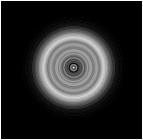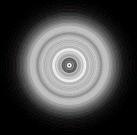Kyklopas
Star Test
Status: 31. March. 2001. Tested at 3 nights
Location: Munich City backyard
Mirror: Still uncoated
Mechanics: Optical tube assembly
without rocker box. Fixed at Polaris. Good collimation.
Seeing: Partly quite good with
diffraction rings identifiable. Most of the time smeared out rings
Ronchi grating 60 lines/inch:
Outside of focus: Straight
lines, even very near focus, with only 3-4 lines. Edges of lines appear
sometimes thicker than in the middle (not sure).
Inside of focus: Straight lines,
even very near focus, with only 3 lines. Lines a bit more smeared out. With only
2 lines left sometimes barrel shaped deformation at edges? (very insecure).
Conclusion: Ronchi at the star is at this
aperture not sensitive enough. Even a overall spherical aberration of
Lambda/4 would show very little bending only
Star test:
Mostly with 4.8 mm Nagler, 520- times magnification 1.2 mm exit pupil. With 7
mm and 9 mm Nagler similar results but more difficult to see tendency.
At focus: At quiet moments
Polaris snaps even in the 4.8 mm eyepiece quite nicely into focus. 9m
companion easily visible despite uncoated mirror and urban sky. Even very small
movements at the focuser defocus the image noticeable. Is this the feeling of an
f/4.1?

Pictures made with "Aberator"
Tried to match appearance at the eyepiece as good as I could |
Outside of focus: Bright thick and well defined outer Ring. Inner rings
well defined and of even brightness. At good moments most inner rings
slightly decreasing in brightness? (not sure)
Just before focus: Only one
small well defined ring left with central obstruction |
 |
Inside of focus: Less contrast in the rings. Single rings only visible
at moments of good seeing. Wide diffuse outside ring smearing outwards
in the seeing. Just inside this ring thin and well defined dark zone.
Inner rings barely identifiable. More light is concentrated towards the
center.
Just before focus: one wide
diffuse ring smearing outwards. Central obstruction appears not as dark
as outside focus. |
Spherical Aberration
Test with 33% central obstruction made of cardboard (see "Star
Testing Astronomical Telescopes" p. 191 ff from H.R. Suiter). At first
glance obstruction emerges at similar distances at both sides of focus. Though,
judgment is difficult due to tiny depth of focus. At more thorough examination
the break out point seems to come outside focus a bit earlier by 1: 1.3
(insecure, could be something between 1:1 and 1: 1.6).
Conclusion: Overall correction must be
pretty good
Masking of Edge
20 mm (0.6") ring masked out with tape, 570 mm (22.4") remaining aperture: Outside focus: barely any
difference. Inside focus: the dark zone just inside the outer ring disappeared completely, but the outer ring still diffuse and smearing outwards
35 mm (1.4") masked, 540 mm (21.2")
remaining aperture: By far more matching appearance!!! Hardly any
difference on both sides of focus. Outside focus: Now, the outer ring not as dominant.
Lessened contrast in the inner rings. Inside focus: The outer ring not smearing
out any more. More contrast in the inner rings.
52 mm (2") masked, 506 mm (20")
remaining aperture: Effect seems to change appearance. Now outside focus
the outer ring appears a bit more diffuse. The Difference is very small, however.
Conclusion: The very edge is not turned
down, otherwise I would have seen an improvement after masking the 20 mm edge.
It must be an overcorrected zone further inside at Radius 0.82-0.95. At Radius
0.8 I seem to have a slightly undercorrected zone. So, the Foucault measurements
seem to be right!
Astigmatism
In general everything round and nice. But in the 4,8 mm eyepiece just outside of focus I see a small oval disc. Difficult to see, but sure. Orientation as seen from the primary: outside focus left - right, inside focus top - bottom. Is this the the "Potato Chip Effect"? After rotating the primary in it's cell by 60° the orientation remains the same and does not rotate with the mirror. So it's definitely not polished in the glass! The effect is really small and not always visible. After hitting the primary it seems to disappear. I guess, the flexible sling to be the reason, that creates hysteresis and introduces axsial forces into the mirror (see article of Nils Olof Carlin). A wiffle tree with rollers could solve the problem, as this minimises the forces in axsial direction (see mirror cell from Roland Herrmann, or Frédéric Géa). Yes, one day I will improve that.
^ to top of this page Home

